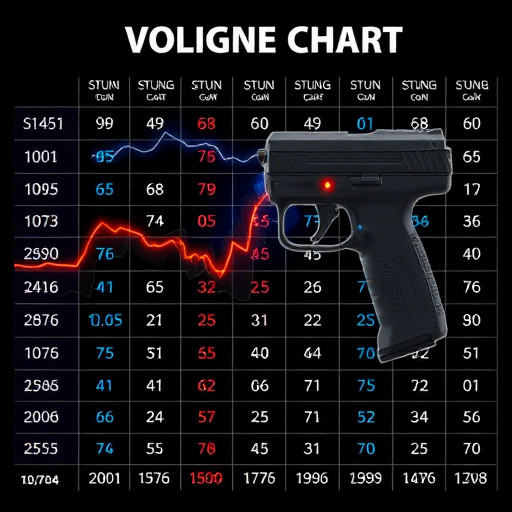Stun guns' performance is measured by voltage (50,000-1,000,000+ volts), which affects the electric charge delivered to attackers, temporarily disabling them. A stun gun voltage chart visually shows these relationships, guiding users to choose the optimal voltage for their needs while minimizing off-target effects and accidental injuries. Key factors influencing stun gun efficiency include device design, probe length, contact area, current type (AC/DC), charge amount, pulse duration, and safety features.
In the realm of self-defense, stun guns have emerged as a powerful tool, but understanding their most effective voltage level is crucial. This comprehensive guide delves into the science behind stun gun voltage, its impact on effectiveness, and how various factors influence performance. From the definition of voltage to real-world applications, we explore the intricacies of stun gun functionality. Moreover, we provide a detailed stun gun voltage chart, highlighting different levels, their advantages, and drawbacks, ensuring users make informed decisions.
Understanding Stun Gun Voltage: What It Means
Understanding Stun Gun Voltage: What It Means
When it comes to stun guns, voltage is a critical factor that determines their effectiveness. A stun gun’s voltage represents the electrical charge delivered to an attacker when activated. This charge disrupts their muscular control and balance, causing them to experience temporary incapacitation. However, not all stun guns are created equal; their voltage outputs can vary greatly, as indicated in a stun gun voltage chart.
Each stun gun manufacturer specifies the voltage of their product, which ranges from 50,000 to over 1 million volts. Higher voltage doesn’t always guarantee better performance; it depends on factors like the device’s design, probe length, and contact area. A well-designed stun gun with optimal voltage can neutralize an attacker effectively while minimizing potential off-target effects or accidental injuries.
– Definition of voltage and its role in stun guns
Voltage is a crucial factor in understanding the performance and effectiveness of stun guns. It represents the electrical potential difference between two points, measured in volts (V). In the context of stun devices, voltage determines the amount of energy delivered to disrupt an assailant’s motor functions temporarily. The higher the voltage, generally speaking, the more powerful the stun, as it requires less current to overcome the target’s skin resistance and cause muscular incapacity or paralysis.
A stun gun voltage chart can offer valuable insights into this relationship. This visual representation typically showcases different voltage levels and their corresponding effects, ranging from mild discomfort to severe incapacitation. Such charts are essential tools for consumers looking to make informed decisions about their personal safety. They can help individuals choose a stun gun with the appropriate voltage for specific situations, ensuring the device will be effective when needed most.
– How voltage affects the stun gun's effectiveness
The stun gun’s effectiveness is directly linked to its voltage output, as measured in volts (V). A stun gun voltage chart typically illustrates this relationship, showing that higher voltage generally translates to a more powerful stun. Voltage is crucial because it determines the energy delivered to the target, affecting both the intensity of the shock and its range.
Higher voltage stun guns can penetrate clothing and skin more effectively, ensuring a stronger response from the target. However, it’s essential to balance power with safety; extremely high voltages may carry risks and could cause accidental injuries if not used properly. Therefore, understanding stun gun voltage and choosing an appropriate level is key to ensuring both effectiveness and responsible usage.
Factors Influencing Stun Gun Voltage Efficiency
Several factors significantly influence the efficiency of a stun gun, and understanding these can help users make informed decisions while navigating a stun gun voltage chart. Firstly, the size and weight of the device play a role; smaller, lighter guns might be more manageable but could potentially deliver lower jolts. Secondly, the type of electrical current used is crucial—AC (alternating current) or DC (direct current)—with DC stun guns generally considered more effective due to their consistent power output.
Additionally, the amount of charge and the duration of the pulse are key performance indicators. Higher voltage doesn’t always equate to better performance; it’s about delivering a strong, focused pulse that overrides the target’s nerve signals. User training and safety features also matter, ensuring users can deploy the stun gun effectively while minimizing risks to themselves and bystanders.
